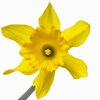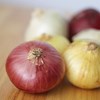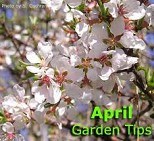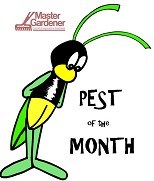Posted 10/16/2012
Do you want to start a new vegetable or garden bed next year?
Now is the time to start preparing the soil. Lay out the area you want to use and cover with 10 – 12 sheets of newspaper (just the black and white sections). Cover that with a mixture of compost and top soil to a depth of about two inches. Finish up with a layer of organic material such as shredded leaves. Keep it moist until it is covered by snow and in the spring the original grass will be dead and the layers you added will have started to deteriorate to the point where you can plant right through it with your vegetable or flower seedlings.
Posted 10/9/2012

Imagine beautiful and fragrant daffodils, hyacinths, and tulips in your home in the middle of winter. Learn how to force spring flowering bulbs into early bloom like the commercial growers do.
CCEFM Master Gardener Jay Ephraim will teach you how in this class. Each participant will go home with two pots of bulbs ready for winter forcing. This is a wonderful class to do as an individual, with friends, school-age children or grandchildren. Pots, bulbs and soil will be supplied.
Choose the class time and location that works for you:
Tuesday, October 30, 6:00 p.m., Shirley J. Luck Senior Center, Johnstown
OR
Thursday, November 1, 6:00 p.m., CCEFM Teaching Center, Canajoharie
The class is limited to 10 participants per location. Materials Cost is $10.00 per person, payable at registration.
To register, call CCEFM at 518-673-5525 ext. 101. Please register as early as possible. Due to the cost of supplies, a minimum number of participants is necessary for the class to be held.
Posted 10/9/2012

Some people think that after a hard frost their gardening chores are done. That is not the case. There are still some housekeeping things to be done that can improve next year's splendor.
- Cut down stems and foliage of herbaceous perennials after two or three hard frosts and when leaves begin to brown. This material can harbor fungus and bacteria spores which will live throughout the winter and reinfect your plants in the spring.
- You can leave seed heads that attract the birds such as coneflowers and liatris. Flower heads also add winter interest to your garden.
- Ornamental grasses look lovely against a backdrop of snow and beetles and other ground insects will winter over in the shelter of the clump. However, cut back Northern Sea Oat grass to about six inches; otherwise your garden will be full of seedlings next year.
-
After several hard frosts add mulch to your perennial flower garden. A one inch layer of straw or chopped leaves will help conserve soil moisture and protect the root system. Run your lawnmower over those fallen leaves and add them to your flower beds. The idea is to keep the soil cool to avoid frost heaving that damages the plant roots. As it decomposes the shredded leaves add nutrients and improve the soil structure. If you prefer, use the more decorative bark mulches.
Posted 10/3/2012
by Christy Hoepting

Optimum conditions for storing onions are 32°F and relative humidity of 65–70 %. Keeping quality after December is directly dependent upon having the onion bulb around 32ºF by mid-December. Under northern climate conditions, it is suggested to aim for 70°F by the end of September, 50°F by the end of October, 40°F by the end of November, and 32°F by mid-December. Onions will freeze at 31°F. The effects of freezing are cumulative. That is, several short periods be-low 31°F are just as damaging as a single longer period. Onions that have frozen become soft and decay quickly. Onions that are held at temps above 50°F are subject to sprouting.
Once the holding temperature is reached, inside air should be re-circulated at least twice a day to maintain a uniform storage condition. Airflow should be 0.25 to 0.5 cubic feet per minute (cfm) per cubic foot of product. Avoid condensation from forming on the onions because it is favorable for sprouting, and disease development and spread in storage: 1) Do not place cool onions in storage early in the morning (storage air temp warmer than onions) and 2) Do not circulate warm air over cold onions, open the storage doors when the air outside is cool and dry to exhaust warm moist air. Remember, humid air contains more moisture and will condensate at warmer temperatures than dryer air. Also, smaller bulbs pack tighter and may need more air circulation.
Monitor storage conditions. Check and test equipment and all controls frequently for proper function during the storage season.
Source: Veg Edge Weekly, Vol. 8 Issue 25
Posted 10/1/2012
Continue composting throughout the year despite winter winds, dropping temperatures and snow. Although the decomposition process usually slows down in cooler weather, compost piles will keep working all year long. Residents of your pile, like bacteria, molds, mites and actinomycetes can survive the cold. However, to prolong their active life over winter they will need warmth, food, air and moisture.
Download this handy fact sheet and follow the tips to optimize your composting in winter months and welcome spring with a productive, healthy compost pile.
Posted 9/19/2012

Composting allows home gardeners to recycle organic material into a useful gardening product.
“Leaves, plants killed by frost, vegetable scraps and grass clippings – all these materials can be composted”, says Robert Nuss, professor of ornamental horticulture in Penn State’s College of Agricultural Sciences. “You can operate a compost pile year-round. The composting process will continue through the coldest days of winter.”
Nearly 30% of the material homeowners throw away can be composted. This keeps these wastes out of landfills and creates a product that adds valuable organic matter to the lawn and garden. “Many landfills no longer accept leaves or garden wastes”, says Nuss. “Composting may be the easiest way for homeowners to dispose of them”.
Download a handy fact sheet.
Posted 9/13/2012
There are several strategies for protecting oneself from ticks and for reducing deer tick population in the landscape. Craig Hollingsworth, Extension Entomologist at the University of Massachussetts offers some additional things to consider as you address the tick populations in your lawn.
Posted 9/13/2012

Fall is a great time to plant trees, shrubs, bulbs, perennials, grass seed and sod. Plants that are planted in the fall enjoy cooler temperatures and ideal growing conditions that allow roots ample time to grow into the surrounding soil.
To plant, dig a hole that is twice the size of your root ball and water it well before you set your new plant. If the plant is root boung with coild of roots at the bottom or roots completely encircle the plant in the pot, cut off the coil of roots at t he bottom and use a knife to score the roots around the sides. There is not need ot fertilize new plants because the feeder roots don't grow until the second year.
September is a good time to transplant and/or divide peonies. Mulch new or transplanted plants wiht two inches of leaves/dried grass clippings to keep the soil warm, encouraging new growth. The recommendation is to wait until after the first heavy frost to put down mulch, helping to keep the ground consistently cool through the winter to prevent heaving and thawing; this will allow newly planted roots as much growing time as possible.
Dispense with deadheading flowering perennials at this time, until the foliage has been killed by frost. The plant needs to shut down at this point and not produce any more flowers.
Early in September, take cuttings of impatiens and begonia to enjoy through the winter months. If annuals are killed by a mid-September frost, cut them off at the roots adn compost the foliage. Leave the roots to decompose and feed the soil.
Begin to plant spring bulbs in your flower garden around the middle of September as the soil temperatures start to drop. Bulbs may continue to be planted until around mid-November or when the ground freezes.
Posted 9/12/2012
Until mid-September (That's this weekend!) it is still a good time to put down grub controls against Japanese beetle and Rose Chafer bug. Be sure to read the label of the product for maximum effectiveness. Note that Milky Spore like soil temperatures of arounf 70 degrees F for an extended period and it doesn't like prolonged freezing temperatures. This makes it less effective as other methods in Zone 3 and 4 gardens.
Posted 9/10/2012
Every year, insects and/or diseases defoliate some trees and we are often asked “will this tree die/be in trouble because all the leaves are gone?”. Usually we can say with confidence that defoliation is not a life-threatening event, but each case is different and to make a best guess, one must consider several variables that can work together to affect the outcome. Start with some questions:
- When did the event happen?
- Which leaves were lost?
- How much foliage was involved?
- Has this happened before? When?
- What was the weather life before and after?
- How vigorous was the tree before defoliation?
First, consider the way that an otherwise healthy tree functions with regard to accumulation and use of carbohydrates. Carbohydrates can be referred to as stored food and the amount of carbohydrates in a tree changes as the growing season progresses. As leaves grow in spring, they use stored food to get bigger and they expand so quickly that they are able to return little of anything to the tree. However, once the leaves reach full size, they begin to make more food than they use and are able to contribute excess photosynthate to storage cells to nourish next year’s complement of leaves. Near the end of the growing season, even though the foliage may still be green, photosynthetic activity slows down and there may be a small loss of food reserves are diverted to a spurt of late-season root growth.







